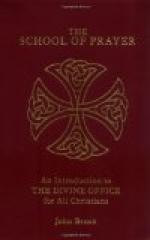Rubrics. The Te Deum is always said at the end of Matins, unless in Matins of Feast of Holy Innocents, of Sundays of Advent, and from Septuagesima to Palm Sunday, and ferias outside Eastertide (from Low Sunday to Ascension Day).
The Structure of the Hymn. In this wonderful composition, there are probably two hymns connected, and followed by a set of versicles and. responses, which might be used with any similar hymn. It is probable that the first hymn (Te Deum ... Paraclitum Spiritum), lines 1 to 13 of Te Deum are older than the second part, which was written probably as a sequel to the early hymn. The rhythm of the hymn is very beautiful, being free from abruptness and monotony. Students of poetry may note that seven lines have the exact hexameter ending, if scanned accentually, as voce proclamant; Deus sabbaoth, etc. Seven have two dactyls, as laudabilis numerus, laudat exercitus; one ends with spondees, apostolorum chorus. The other six lines have a less regular ending.
This hymn of praise to the Blessed Trinity is divided into two parts and seems to be modelled on the lines of the Psalm 148, Laudate Dominum de coelis (see Sunday Lauds I.). The verses 1 to 6 of the hymn, like the opening verses of the psalm, record the worship and adoration of the angels. The second part of the hymn records the worship of human beings living or dead—Apostles, Prophets, Martyrs. The second hymn, Tu Rex gloriae Christi, etc., is a prayer to Christ, the God Incarnate, the Redeemer now in Glory, to aid His servants and to aid them to be of the number of His saints in everlasting glory.
The third part of the hymn, vv. 22-29 (Salvum fac ... in aeternum) is considered by scholars to be simply versicles, responses and prayers; the verses 22-23 (Salvum fac... usque in aeternum). being the versicle, and verses 24-25 (Per singulos dies... saeculi), verse 2 of Psalm 144 being the response before the beautiful verses of prayer “Dignare Domine die isto sine peccato nos custodire,” etc. “Vouchsafe, O Lord, to keep us this day from sin; O Lord, have mercy on us,” etc., etc.
This hymn has a special interest for Irish priests, as the Irish recensions of it, found in the Bangor Antiphoner (to be seen in the Library of Trinity College, Dublin) are of the greatest value to scholars engaged in critical study. They date from the tenth century, and give Nicetas as the author. The wording in the old Irish Antiphoner differs in some verses from the text given in our Breviary. Thus, in verse 6, the Bangor text has, universa before the word terra; again, in verse 18, the Breviary reads “Tu ad deteram Dei sedes,” Bangor, and probably more correctly, reads sedens. Verses 26-29, “Dignare Domine... confundar in aeternum” are not found in the Irish book. Those who wish to study these old Irish MSS. may receive great help from Warren’s Bangor Antiphoner (II., pp.83-91) and light comes too from Julian’s Dictionary of Hymnology (pp. 1120-1121).




